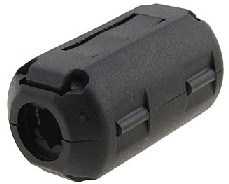Because the items are going to have to remain in close proximity, it's unlikely that there is anything that will completely solve your problem, but there are a couple of things you can try.
If the lights are wired, it is possible that the wire is working as an antenna, and you can use a Ferrite Choke or two on the wire.

Tape one near where the wire leaves the battery, and another to where the wire lead plugs into the light. The can be found at stores like RadioShack for a few bucks.
If the lights are wireless, aluminum and tin foil is an excellent reflector for this kind of Electro-Magnetic Interference (EMI).
The first step would be to see if foil will help. Try wrapping the outside of the lights with foil and repeating the tests you did before. I doubt you can add foil to the computer because this will interfere with it picking up the wireless signal from the sensors.
If that reduces the interference you can tape the foil to the lights, carefully cutting away the foil around mounting brackets and buttons and see if the EMI is still reduced. If the lights can be easily disassembled you can try taking them apart and lining the interior with foil as well; take care not to short out the internal electronics.
Good Luck.

